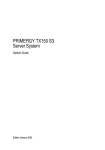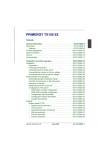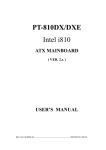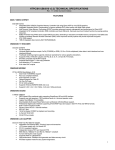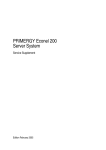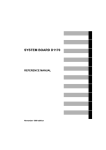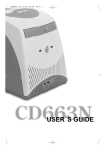Download SYSTEM BOARD D1170
Transcript
SYSTEM BOARD D1170 ADDITIONAL TECHNICAL MANUAL Is there ... ... any technical problem or other question you need clarified? Please contact: • Our Hotline: Mo-Fr: 8 a.m. - 6 p.m. Sat: 9 a.m. - 2 p.m. Tel.: ++49 (0) 180 3777 005 • your sales outlet The latest information on our products, tips, updates, etc., can be found on the Internet under: http://www.fujitsu-siemens.com Dieses Handbuch wurde auf Recycling-Papier gedruckt. This manual has been printed on recycled paper. Ce manuel est imprimé sur du papier recyclé. Este manual ha sido impreso sobre papel reciclado. Questo manuale è stato stampato su carta da riciclaggio. Denna handbok är tryckt på recyclingpapper. Dit handboek werd op recycling-papier gedrukt. Herausgegeben von/Published by Fujitsu Siemens Computers GmbH Bestell-Nr./Order No.: A26361-D1170-Z180-4-7619 Printed in the Federal Republic of Germany AG 0100 01/00 A26361-D1170-Z180-1-7619 SYSTEM BOARD D1170 ADDITIONAL TECHNICAL MANUAL English System Board D1170 Additional Technical Manual January 2000 edition Intel, Pentium and Celeron are registered trademarks and MMX and OverDrive are trademarks of Intel Corporation, USA. Microsoft, MS, MS-DOS and Windows are registered trademarks of Microsoft Corporation. PS/2 and OS/2 Warp are registered trademarks of International Business Machines, Inc. All other trademarks referenced are trademarks or registered trademarks of their respective owners, whose protected rights are acknowledged. Copyright ã Fujitsu Siemens Computers GmbH 2000 All rights, including rights of translation, reproduction by printing, copying or similar methods, even of parts are reserved. Offenders will be liable for damages. All rights, including rights created by patent grant or registration of a utility model or design, are reserved. Delivery subject to availability. Right of technical modification reserved. Contents Introduction........................................................................................................................................1 Notational conventions ..............................................................................................................1 Features ............................................................................................................................................2 Mechanics .........................................................................................................................................3 Connectors and jumpers............................................................................................................5 Power supply monitoring....................................................................................................5 Power supply ATX connector.............................................................................................5 Front panel connector........................................................................................................6 Fan 2 .................................................................................................................................6 Chipcard reader port (internal) or serial port 2 (external via optional cable) .......................7 Fan 4 .................................................................................................................................7 Wake on LAN (WOL) connector.........................................................................................7 Intrusion connector for case open detect for optional push button (opener) .......................8 IrDA (internal) ....................................................................................................................8 I2C connector (primary SMBus) for optional temperature sensor (e.g. LM75).....................8 Auxiliary (MPEG, TV) audio connector (internal)................................................................9 CD-ROM audio connector (internal)...................................................................................9 Fan 1 .................................................................................................................................9 Fan 3 ............................................................................................................................... 10 USB chipcard reader ....................................................................................................... 10 External temperature sensor (thermal SMBus) (LM75, T26139-Y3718-V1) ..................... 10 Configuration ........................................................................................................................... 11 Functions controlled by the switch block .......................................................................... 11 Supported ACPI system states ........................................................................................ 11 ACPI wakeup possibilities................................................................................................ 12 USB power jumper function description ........................................................................... 12 BIOS options ................................................................................................................... 12 Messages ........................................................................................................................ 13 Power ...................................................................................................................................... 13 Power requirement .......................................................................................................... 13 Power loadability.............................................................................................................. 13 Documentation ................................................................................................................................ 14 Installing drivers .............................................................................................................................. 14 Upgrading main memory ................................................................................................................. 15 Troubleshooting............................................................................................................................... 16 Message BIOS update............................................................................................................. 16 The screen stays blank............................................................................................................ 16 A26361-D1170-Z180-4-7619 Introduction i This system board is available in different configuration levels. Depending on the hardware configuration of your device, it may be that you cannot find several options in your version of the system board, even though they are described. You may find further information e. g. in the complete Technical Manual for the system board and in the description "BIOS Setup". Further information to drivers is provided on the supplied driver diskettes or on the "Drivers & Utilities" or "ServerStart" CD. For detailed information please look at chapter "Installing drivers". The latest BIOS version or drivers can be found on the internet under http://www.fujitsusiemens.com/en/service Notational conventions The meanings of the symbols and fonts used in this manual are as follows: ! i Ê Pay particular attention to texts marked with this symbol. Failure to observe this warning endangers your life, destroys the system, or may lead to loss of data. This symbol is followed by supplementary information, remarks and tips. Texts which follow this symbol describe activities that must be performed in the order shown. Ë This symbol means that you must enter a blank space at this point. Ú This symbol means that you must press the Enter key. Texts in this typeface are screen outputs. Texts in this bold typeface are the entries you make via the keyboard. Texts in italics indicate commands or menu items. "Quotation marks" indicate names of chapters and terms that are being emphasized. A26361-D1170-Z180-4-7619 1 Features Features The table shows an assembly version of this system board as example. Function D1170-A Processor socket PGA 370 Processor Intel Celeron or Pentium III Formfactor µATX Front Side Bus in MHz Chipset 66/100/133 i810e Memory sockets 2 DIMM ISA slots -- PCI slots 4 ISA/PCI shared -- AGP-Port -- System monitoring -- Thermal Management -- Wake On LAN x Keyboard On -- IrDA -- Chipcard reader -- Save to Disk (ACPI S4) x Save to RAM(ACPI S3) x LAN onboard -- Audio onboard AD 1881 VGA onboard i 810e 4MB Display Cache ! -- Computer system boards and components contain very delicate IC chips. To protect them against damage caused from electric static, you have to follow some precautions: • • • Unplug your computer when you work inside. Hold components by the edge, don't touch their leads. Use a grounded wrist strap. Place the system board and the components on a grounded antistatic pad whenever you work outside the computer. Once you have installed the system board, you should remove the battery protection (i.e. the thin plastic plate between battery and contact spring). 2 A26361-D1170-Z180-4-7619 Mechanics Mechanics Layout ATX 12"' x 8'' (304,8 mm x 203,2 mm) 2 1 1= 2= 3= 4= 5= 6= PS/2 keyboard port PS/2 mouse port Parallel port Serial port 1 USB port B USB port A 3 4 5 6 PCI 1 PCI 2 PCI 3 PCI 4 PCI 5 AGP Some of the following connectors are optional and may therefore not be included on your system board. 8 7 9a 9b 9c 7 = LAN port 8 = Game/Midi port 9a = Audio Line-Out 9b = Audio Line-In 9c = Audio Micro-In The components and connectors marked do not have to be present on the system board. A26361-D1170-Z180-4-7619 3 Mechanics 1 2 3 4 5 6 7 8 9 10 11 12 19 18 1= 2= 3= 4= 5= 6= 7= 8= Power supply monitoring Power supply IDE drives 3 and 4 (secondary) Connector for front panel IDE drives 1 and 2 (primary) Fan 2 for CPU 1 (processor 1) Floppy disk drive Serial chipcard reader interface or serial port 2 9 = Fan 4 (e. g. for the optional fan (AUX)) 10 = Wake On LAN 11 = Intrusion switch 17 16 15 PCI 1 PCI 2 PCI 3 PCI 4 PCI 5 AGP 13 14 12 = IrDA 13 = I²C (primary SMBus) 14 = AUX-In 15 = CD-In 16 = Fan 1 for CPU 0 (processor 0) 17 = Fan 3 (e. g. for the optional fan (system)) 18 = USB chipcard reader 19 = Temperature sensor (AUX) (thermal SMBus) The components and connectors marked do not have to be present on the system board. 4 A26361-D1170-Z180-4-7619 Mechanics Connectors and jumpers Some of the following connectors are optional! Power supply monitoring 1 Pin Signal 1 2 3 4 5 6 7 8 AC Outlet (high asserted) PS Fan Control (high asserted) PS FAN pulse PS FAN pulse SMB CLK SMB DATA VCC EEPROM (+3.3 V) GND Power supply ATX connector 20 11 10 1 Pin Signal Pin Signal 1 2 3 4 5 6 7 8 9 10 +3.3 V +3.3 V GND +5 V VCC GND +5 V VCC GND Powergood (high asserted) +5 V Auxiliary +12 V 11 12 13 14 15 16 17 18 19 20 +3.3 V -12 V GND PS on (low asserted) GND GND GND -5 V +5 V VCC +5 V VCC A26361-D1170-Z180-4-7619 5 Mechanics Front panel connector Power On/Off Reset 1) Message LED HD-LED 1) 1) Power On LED 1) 1 2 1) Sleep SCSI LED Input 1) 2) Speaker 2) 1) Cable is not included in the delivery scope. 2) The same interface. Pin Signal Pin Signal 1 3 5 7 9 11 Not connected Standby LED (Anode) Key PON_LED (Anode) PON_LED (Anode) PON_LED (Cathode/GND) Standby LED (Cathode/GND) Message LED (Anode) Message LED (Cathode) Key HD_LED (Anode) HD_LED (Cathode) GND Power button (low asserted) Sleep button (low asserted) Reset button (low asserted) 2 4 6 81) 10 12 Speaker Key GND VCC or GND Key pin Key pin 14 16 18 20 22 24 26 28 30 Key Not connected SCSI LED input (low asserted) SCSI LED input (low asserted) Not connected Key GND GND GND 13 15 17 19 21 23 25 272) 29 1) Pin 8 is connected to VCC if audio is not onboard. Pin 8 is connected to GND if audio is onboard. 2) The sleep button (optional) functions only for operating systems with APM (not with ACPI). Fan 2 6 1 Pin Signal 1 2 3 GND Controlled fan voltage (0 V, 6 ... 12 V) Fan sense A26361-D1170-Z180-4-7619 Mechanics 2 Chipcard reader port (internal) or serial port 2 (external via optional cable) 1 Pin Signal Pin Signal 1 3 5 7 9 11 13 15 DCD (low asserted) SIN (high asserted) SOUT (high asserted) DTR (low asserted) GND EXT SMI (low asserted) Not connected 2 4 6 8 10 12 14 16 DSR (low asserted) RTS (low asserted) CTS (low asserted) PC_ON_Strobe VCC auxiliary VCC GND Key GND Fan 4 1 Pin Signal 1 2 3 GND +12 V FAN sense Wake on LAN (WOL) connector 1 Pin Signal 1 2 3 VCC auxiliary GND Wake pulse (high asserted) A26361-D1170-Z180-4-7619 7 Mechanics 1 Intrusion connector for case open detect for optional push button (opener) Pin Signal 1 2 3 GND Case open (low asserted) Intrusion switch present (low asserted) IrDA (internal) 1 Pin Signal 1 2 3 4 5 VCC Key IRRX_H GND IRTX_H 2 I C connector (primary SMBus) for optional temperature sensor (e.g. LM75) 8 1 Pin Signal 1 2 3 4 3.3 V standby Clock Data GND A26361-D1170-Z180-4-7619 Mechanics Auxiliary (MPEG, TV) audio connector (internal) 1 Pin Signal 1 2 3 4 Left AUX audio input Analog GND Analog GND Right AUX audio input CD-ROM audio connector (internal) 1 Pin Signal 1 2 3 4 Left CD audio input CD GND CD GND Right CD audio input Fan 1 1 Pin Signal 1 2 3 GND Controlled fan voltage (0 V, 6 ... 12 V) FAN sense A26361-D1170-Z180-4-7619 9 Mechanics Fan 3 1 Pin Signal 1 2 3 GND Controlled fan voltage (0 V, 6 ... 12 V) FAN sense USB chipcard reader 1 2 Pin Signal Pin Signal 1 3 5 7 9 11 13 +3.3 V standby Data negative up Data negative down GND Not connected +3.3 V Chipcard reader On (low pulse) 2 4 6 8 10 12 14 VCC Data positive up Data positive down GND +5 V auxiliary Power OK (high asserted) Key External temperature sensor (thermal SMBus) (LM75, T26139Y3718-V1) 10 1 Pin Signal 1 2 3 4 3.3 V standby Clock Data GND A26361-D1170-Z180-4-7619 Mechanics Configuration Functions controlled by the switch block Function SW1 PWS Password Skip on Off off Recovery BIOS X Off X Floppy write protect X Off X RTC - Reset and Clear X CMOS* Off X * RES is the onboard inscription for RTC ! SW2 RCV SW3 FWP SW4 AUX X X on off X X X X X X X on off X X X X X X X on X X off RES switch must not be in ON position during normal operation! Supported ACPI system states • • • • • S0 (working) S1 (sleeping) S3 (save to RAM) S4 (OS hibernate) S5 (soft off) ACPI Switches: On/Off/Sleep/Wake by power button On/Off/Sleep/Wake by keyboard-button A26361-D1170-Z180-4-7619 11 Mechanics ACPI wakeup possibilities Wakeup source Wakeup possible from system states Power button Keyboard button RTC (real-time clock = timer) Serial chipcard reader External serial port 1 (ring signal) PCI-card PME# signal S1 – S5 S1 – S5 S1 – S4 S1 – S4 S1 – S4 S1 – S4 (3.3V Aux power is provided to PCI cards by the system board) S1 – S4 S1 – S4 S1 – S4 (5V Aux power is provided to the USB device by the system board) S1 Onboard LAN controller Internal USB chipcard reader USB device Keyboard / mouse USB power jumper function description 1 Pin Signal 1 2 3 VCC USB power connection VCC_AUX Jumper 2-3 Jumper 1-2 Default setting: If the power supply supports auxiliary voltage the USB interface is permanently powered except when the main supply is plugged off. Wakeup from ACPI S1-S4 state possible. The USB interface is only powered in operating state. Wakeup from ACPI S1 state possible. BIOS options Please refer to BIOS description on the including CD-ROM (menu Advanced System Management ). 12 A26361-D1170-Z180-4-7619 Mechanics Messages The Message LED (frontpanel connector) shows two different states: • A slow blinking (once a second) of the LED signals that any application has received a message. (ACPI- mode) • A fast blinking (five times a second) of the LED signals a hardware problem. The fast blinking LED can have several different causes: − a necessary sensor is missing or defect − an available sensor has overtemperature − a fan is defect or not working properly − a software is responsible for blinking More detailed information are shown with an additional System Monitoring Software or on the monitor after reboot entering BIOS Setup (menu Advanced System Management ). i BIOS: Please refer to BIOS description on the including CD-ROM. Power Power requirement Source Voltage Maximum variation Maximum current Main power supply +5.0 V ±5 % 15 A Main power supply +12 V ±10 % 350 mA Main power supply -12 V ±10 % 150 mA Main power supply +3.3 V ±5 % 4A Auxiliary power supply +5.0 V ±5 % 1A Auxiliary power supply +5.0 V ±5 % 2A Onboard power supply 1.8 - 3.5 V ±5 % 14 A * Refer to chapter "USB power jumper function description". Comment without Wake On USB* with Wake On USB* Power loadability Fuse number Maximum fuse current Function Maximum function current 1 750 mA 2 3 750 mA 750 mA Keyboard Port Mouse Port Game Port Universal serial bus (USB) Port A Universal serial bus (USB) Port B Not specified Not specified Not specified 500 mA 500 mA A26361-D1170-Z180-4-7619 13 Documentation Documentation Ê Ê Ê Ê Ê Ê Insert the "Drivers & Utilities" CD. If the CD does not start automatically, run the START.EXE file in the main directory of the CD. Select your system board or your device. Select Documentation. Select - Technical Manuals Select - Technical Manuals (BIOS) i You may have to install the Acrobat Reader - Software on the CD-ROM (path: utls/acrobat) before reading! For more details please read the according readme.txt files. Installing drivers Ê Ê Ê 14 Insert the "Drivers & Utilities" CD. If the CD doesn't start automatically call the START.EXE file in the main directory of the CD. If the system board list is displayed select the system board or select under Driver the operating system used and the audio and video drivers. A26361-D1170-Z180-4-7619 Upgrading main memory Upgrading main memory These slots are suitable for 64 to 512 Mbyte RDRAM memory modules of the RIMM format. The permissible total size of the main memory is 1 Gbyte. Memory modules with different memory capacities can be combined. ! All locations must always be occupied. Missing memory modules must be replaced with a C-RIMM module. This C-RIMM module must then be installed in the order of the locations behind the RIMM memory module: Location bank 0 = RIMM memory module Location bank 1 = C-RIMM memory module The system board supports a maximum of 32 RDRAM modules at all locations for the main memory combined: Technology Total size of RIMM module Number of chips 64 Mbit 64 Mbyte 96 Mbyte 128 Mbyte 64 Mbyte 128 Mbyte 192 Mbyte 256 Mbyte 128 Mbyte 256 Mbyte 384 Mbyte 512 Mbyte 8 12 16 4 8 12 16 4 8 12 16 128 Mbit 256 Mbit ! You may only use 2.5 V RIMM memory modules. The system board supports memory modules of the speed classes PC600, PC700 and PC800. Always use memory modules of the same speed class. Otherwise the memory speed is limited to the slowest speed class. Optimal system speed is achieved when you use PC800 RDRAM memory modules. A26361-D1170-Z180-4-7619 15 Troubleshooting Troubleshooting Message BIOS update The System BIOS provides optimum support for the processor you have chosen. If the message BIOS update for installed CPU failed appears the microcode required for the processor inserted must still be loaded. Further information on this is available in the "BIOS Setup" manual on the "Drivers & Utilities" CD provided. The screen stays blank If your screen stays blank this may have the following cause: The wrong RAM memory module has been inserted Ê See the chapter "Main Memory" for information which memory modules can be used. Two processors with different FSB clock frequencies have been inserted The FSB Mismatch LED is bright. Ê Ensure that both processors operate at the same FSB clock frequency. ACPI S3 (Save-to-RAM) and/or ACPI S4 (Save-to-Disk) doesn't work This system board is fully compliant for ACPI S3 and S4. Therefore it is PC98 certified by Microsoft. If you have any problems with ACPI please ensure that all of your components are supporting ACPI S3 and S4. ! 16 − Operating System − Hardware and drivers of controllers (e. g. VGA, audio, LAN, SCSI controllers). The system board D1160 supports Save-to-RAM. Therefore the D1160 is certified by Intel and Microsoft. This support must be also guaranteed by the operating system, the extension boards and the power supply. For the time neither Windows 98 1st edition nor Windows NT4.0 support this function reliably. Windows 98 SE and Windows 2000 will support ACPI S3. Unfortunately only a few extension boards work with functional Save-toRAM compliant drivers (refer to http://developer.intel.com/technology/iapc/involve.htm ). A26361-D1170-Z180-4-7619

























